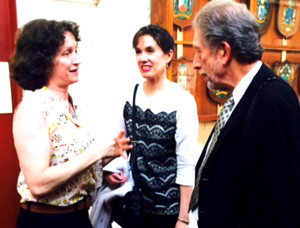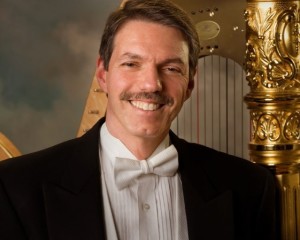
THE AUTHOR, left, with conductor David Ramadanoff and his wife, Pamela Martin, after Sunday’s concert.
Courtesy photos
Whenever I sit down to compose a review, I try to be as unbiased as possible. Wherever I find fault, I try to present it in a positive light. In that spirit, I can honestly say that Ramadanoff’s supporters all hope that the maestro will soon find another place to pursue his passion. The thing is, even if that were to happen, it wouldn’t resolve the sad situation created by the VSO’s board of directors when they decided that the only way to save their organization from bankruptcy was to “offer a new product.”
Translation: fire their esteemed conductor of 32 years and start over.
It was an emotional time for almost everyone present at Sunday’s concert at Lander Hall on Mare Island, so I feel it is appropriate to place my review in this context. The polite but somber mood that hung over the performance hall was as pronounced as the notes produced by the musicians’ instruments.
Ramadanoff arrived onstage to enthusiastic applause, a repeat of the standing ovation he received at the onset of the symphony’s previous concert in January. The conductor graciously thanked the audience and, in his trademark style, deflected their praise onto the musicians. He then proceeded to introduce the day’s program, titled “Serenité.”
The program lineup surveyed a time of transition in Paris during the early part of the 20th century. Claude Debussy and Maurice Ravel created music that established what we now refer to as Impressionism, according to Ramadanoff, and the subsequent works of Francis Poulenc, Arthur Honegger and Jacque Ibert represented a blossoming out from that distinctive style. The works of Bela Bartok, Ramadanoff explained, also exemplify the spirit of experimentation that prevailed in the period.
Sunday’s concert opened with Bartok’s “Romanian Dances,” reportedly inspired when the composer overheard a Transylvanian nanny singing folk songs to the children in her care. Bartok later embarked on a journey to collect folk tunes from the people of Hungary.
In the first movement, “Stick Dance,” the violins provide a unison beat, danced upon by a delicate melody emanating from the winds. The second, “Sash Dance,” has a mysterious tone, as if the dancers would be performing on a stage, veiled and seductive. In all of the dances there was tremendous clarity, precision and feeling in the symphony’s rendering, yet alongside that perfection was also a sense of muting, in both overall volume and physical energy.
The second item on the program was “Danses sacrées et profanes” by Debussy, featuring harpist Dan Levitan. This selection is another rather sedate, mysterious and seductive one, but it also contains that special, magical quality that can only spring from this serene instrument. An other-worldly magic shone through in Levitan’s execution of both the accompanying and solo harp parts.
The audience was treated to a particularly grand show of musicianship when a fairly loud bang was heard coming from the stage area and failed to cause disruption in play. It turns out the harp had popped a string. As Levitan went about replacing it after the conclusion of the piece, the audience was treated to an impromptu narration of the re-stringing process and its significance from alert concertmaster Kathleen Comalli Dillon.The repair was completed in minutes, and the orchestra continued its program with Ravel’s “Introduction and Allegro,” a piece commissioned by a harp manufacturer in 1904 to demonstrate the special qualities of its new, double-action pedal harp. Ramadanoff explained that what we heard Sunday was a later orchestration of the piece, performed on a very different instrument. Originally composed as a septet, he noted, the work is often referred to as a mini-concerto since the harp is so prominently featured.
As one might imagine, the work commissioned to show off the capabilities of the instrument calls for a high level of proficiency on the part of the musician. Levitan proved well-equipped to achieve the desired result. The harp was the belle of the ball, filling the performance hall with its magical allure, beautifully accompanied by the polished and attuned orchestra.
The second half of the program opened with “Two Marches and an Interlude” by Francis Poulenc, composed in 1937 to accompany an exhibition dinner. Ramadanoff explained that the first “course” is the most conservative, a simple march with little dissonance — the “sherbet and coffee,” he suggested. The second movement is more rustic, something that might have accompanied a provincial “cheese course”; and the third is the most modern of the three movements, in which dissonance takes center stage.
In the program notes, VSO board member Mary Eichbauer explained that the first movement of the Poulenc work, “March 1889,” evokes a cheerful nostalgia for the Belle Epoque period, whereas the concluding “March 1937” is much darker, a quality that might well have reflected the composer’s uncertainty about the now infamous “march of progress” of that era in European history. Ultimately, I found the bassoon in the third movement to be the most expressive element, evoking a powerful sense of intense contemplation.
Following the Poulenc selection was Arthur Honegger’s 1920 “Spring Pastoral.” Once again, as in the opening Bartok dances, the music was intensely evocative, precisely played and with tremendous unity among the orchestral sections, yet it felt restrained in its overall ambience.
The piece opens with a very quiet, melodic humming from the strings, followed by a moaning, low-level theme from the horns. The lulling melody evokes an image of soaring over a pastoral scene. At one point, as the melody line was taken up by the clarinet, then passed along to the flute, a refreshing interlude of pure beauty suddenly and inexplicably interrupted the otherwise subdued tone of the day.
The concert concluded with Jacques Ibert’s unusual and very dissonant “Divertissiment,” inspired by the musical score for a play written in 1851, “An Italian Straw Hat,” in which two lovers are compromised when a passing horse munches on the lady’s hat, which she has left resting on a neighboring bush. Appropriately, the music is surprising, uncomfortable and unpleasant.
From the start, the piece is rebellious in nature, defying convention with its off-handed cacophony. It is a crazed sound, teasingly interspersed with familiar passages from popular works of the period. Eichbauer sums it up well in her description of the fourth, “Valse” movement: “cleverly orchestrated, but always on the edge of annoying … a cymbal crash is funny for being over the top, and the trombone can’t stop laughing.”
Ramadanoff had another way of describing the seemingly nonsensical work: “A little bit of tongue-sticking-out,” he called it, referring of course to the jokester style that is prevalent in this as well as many of the composer’s other works. The conductor also noted the prankish sound of the piano toward the end of the piece, where he imagines Ibert “assaults the piano with his fists or elbows.” Even in its conclusion, the piece seems to hold back from ever quite satisfying its mischievously sustained tension.
Before Ramadanoff was able to make his exit at the conclusion of Sunday’s program, a few stalwart fans commandeered the stage, presenting him with a bouquet of flowers so elaborate that he felt compelled, with apologies to the givers, to dismantle the creation and share its blossoms with each of the musicians.
In roughly these words, Dr. Thomas Snyder told Ramadanoff: “You came here in 1983 to lead a group of dedicated amateur musicians. They are now a group of dedicated, talented professionals. You have thrilled us and inspired us with your consummate musicianship.”
Dr. Snyder went on to tell of the many musicians and soloists who have come to play for the Vallejo Symphony at reduced fees because it was such a privilege to play with the man who mentored and inspired them all.
Dr. Snyder, a Navy veteran, offered Ramadanoff a traditional Navy sendoff, which he felt was all the more appropriate given the former naval base where the performance took place: “Fair winds, and following seas.” Those few words spoke volumes on behalf of everyone who was there to bid farewell to this inimitable, inspiring human being.
On Sept. 20, the Vallejo Symphony will open its 84th season with a concert/audition at which the first of three conductor candidates will lead the orchestra in a program of his choosing. At the end of the season, one candidate will be named music director and begin official duties with the 2016-17 season. Thomas Heuser, music director of the Idaho Falls Symphony since 2011, will conduct the Sept. 20 concert.
For more information about Heuser and other candidates, visit the Vallejo Symphony website, www.vallejosymphony.org.
Elizabeth Warnimont is a freelance writer specializing in the performing arts. She is also a substitute teacher for the Benicia Unified School District.







Leave a Reply